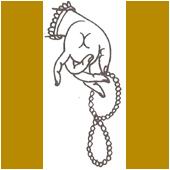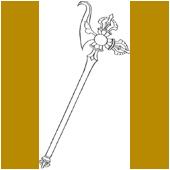
A
Abhayamudra
Hand gesture of a Buddha image representing the dispelling of fear, or the giving
of protection. The right hand is held out at chest level, palm outward and the
fingers pointing up, usually seen on a standing image. In Thailand the same
gesture is also performed with the left hand or both hands. The gesture of raising
both hands can be interpreted as calming the ocean.
Akshamala
The akshamala is a string of 108 bead. The mantra is articulated loudly or mentally over each bead. Two akshamalas joined together serve as a way of counting the round mode.
In the Buddhist tradition this is a special attribute of Avalokiteswear, who has an akshamala made of crystal beads. When it is turned it means he is drawing the people out of cyclic existence and leading them to Nirvana.

Amitabha
The Buddha of the past and transcendental Buddha of Mahayana Buddhism. He eventually
replaced the Shakyamuni Buddha in importance in china and Japan. By calling
on him, one can be reborn in paradise and consequently attain Buddhahood in
one’s next rebirth. He is one of the most popular jinas, and one of his emanations
is the Avalokitesvara, who always wears a figure of Amitabha in his headdress.
Usually shown seated in meditation.
Amulet
A protective ornament or charm believed to protect the wearer from misfortune.
Ananda
The Buddha's cousin and his chief disciple. In art, often represented as a young
monk with the elderly Kassapa.
Angkor
"City; capital." An ancient capital in Cambodia, the center of the Khmer empire
from 802 to 1432 C.E.
Angkor Thom
The great city that was built in the 12th century C.E. by the Khmer
king Jayavarman VII. It is located north of Angkor Wat, with the great temple
of the bayon at its center.
Angkor Wat
The largest of the Khmer temples. Built in the early 12th century
C.E. by King Suryavarman II, it is dedicated to Vishnu. It is a replica in stone
of Khmer cosmology: its five towers symbolize Mt. Meru's five peaks, the enclosing
wall represents the mountains at the edge of the world, and the surrounding
moat, the oceans beyond.
Animism
The belief that all animate and inanimate things have a soul.
Ankusha
In its ordinary form it is actually a good with a hook used as an elephant’s prod. As a ritual artifact it symbolizes the hook which can lift anyone from his doubts or the Doctrine of the Buddha.

Annam
Former country of Southeast Asia incorporated into Vietnam in 1946 as central
Vietnam. Bronze age civilization flourished there when it was conquered by the
Chinese in approximately 214 B.C.E. The Chinese named it An Nam, "peaceful south."
It became independent in 1428.
Apsaras
Female divinities; celestial dancers who are the attendantsof Kama, the god
of love. The nymphs of Indra's heaven and the companions of the gandharvas.
They are able to change shape at will, and are employed by the gods to seduce
ascetics.
Ardhanari
A composite image of male and female energy depicted as the Hindu god Shiva,
with his consort Uma or Parvati. The right side is that of the god and the left
is his consort.
Aryan
A group of people who migrated to India from central Asia during the second
millennium B.C.E. bringing their own language, culture, and religion. Their
rituals and ideas are recorded in the Vedas.
Ashoka
The Indian emperor who unified India and ruled from approximately 273 to 236
B.C.E. During his reign Buddhism was adopted as the state religion. He erected
stone pillars and rock tablets inscribed with Buddhist ethics throughout his
empire and sent Buddhist missionaries to many parts of Asia, including Ceylon
and Southeast Asia.
Ashram
A hermitage retreat for holy men and women.
Atman
Philosophical concept of universal soul or spirit in Hinduism.
Attributes
Particular identifying objects held in the hands of some Hindu gods and goddesses,
such as a lotus, a book, a chakra, or a club.
Avalokitesvara
A compassionate male deity in Mahayana Buddhism who delays his own attainment
of Buddhahood until he has helped all humankind to reach that goal. The image
of Amitabha is seen in his headdress. His body is sometimes covered with numerous
small images of the Buddha. He has many forms with different names; in Southeast
Asia he is called Lokesvara and Padmapani. In Khmer art, he carries a rosary,
book, flask, and lotus. In china, he is a feminine goddess of mercy, called
Kuan Yin, and in Japan, Kwannon.
Avatara
Descent; in particular, the descent of a deity from heaven who is incarnated
on earth, usually referring to the Hindu god Vishnu. His avataras have included
his incarnation as a fish; a boar; a tortoise; a man-lion; a dwarf; Rama with
an axe; the gentle Rama, hero of the Ramayana; Krisha; the buddha; and the white
horse Kalki, who is to appear at the end of the age of Kali.
Ayodhya
"Not conquered." Rama's capital in the Indian epic poem, the Ramayana. Also,
a contemporary city in North India.
Ayutthaya
A kingdom which flourished in thailand between 1350 and 1776. Art produced during
this period is classified as Ayutthaya style. Also, the name of a contemporary
city in Thailand. The name is derived from the Indian "Ayodhya."